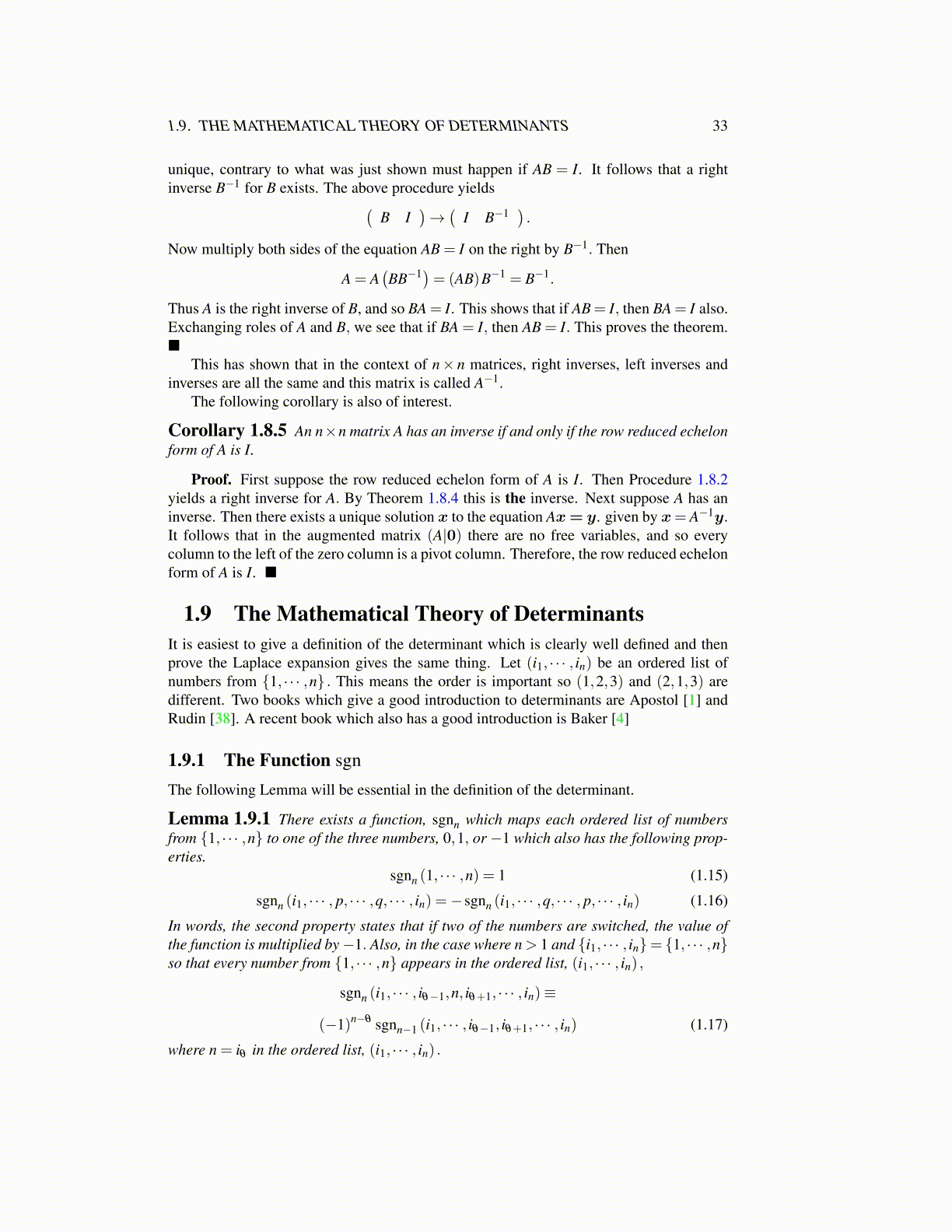
1.9. THE MATHEMATICAL THEORY OF DETERMINANTS 33
unique, contrary to what was just shown must happen if AB = I. It follows that a rightinverse B−1 for B exists. The above procedure yields(
B I)→(
I B−1).
Now multiply both sides of the equation AB = I on the right by B−1. Then
A = A(BB−1)= (AB)B−1 = B−1.
Thus A is the right inverse of B, and so BA = I. This shows that if AB = I, then BA = I also.Exchanging roles of A and B, we see that if BA = I, then AB = I. This proves the theorem.■
This has shown that in the context of n× n matrices, right inverses, left inverses andinverses are all the same and this matrix is called A−1.
The following corollary is also of interest.
Corollary 1.8.5 An n×n matrix A has an inverse if and only if the row reduced echelonform of A is I.
Proof. First suppose the row reduced echelon form of A is I. Then Procedure 1.8.2yields a right inverse for A. By Theorem 1.8.4 this is the inverse. Next suppose A has aninverse. Then there exists a unique solution x to the equation Ax= y. given by x= A−1y.It follows that in the augmented matrix (A|0) there are no free variables, and so everycolumn to the left of the zero column is a pivot column. Therefore, the row reduced echelonform of A is I. ■
1.9 The Mathematical Theory of DeterminantsIt is easiest to give a definition of the determinant which is clearly well defined and thenprove the Laplace expansion gives the same thing. Let (i1, · · · , in) be an ordered list ofnumbers from {1, · · · ,n} . This means the order is important so (1,2,3) and (2,1,3) aredifferent. Two books which give a good introduction to determinants are Apostol [1] andRudin [38]. A recent book which also has a good introduction is Baker [4]
1.9.1 The Function sgn
The following Lemma will be essential in the definition of the determinant.
Lemma 1.9.1 There exists a function, sgnn which maps each ordered list of numbersfrom {1, · · · ,n} to one of the three numbers, 0,1, or −1 which also has the following prop-erties.
sgnn (1, · · · ,n) = 1 (1.15)
sgnn (i1, · · · , p, · · · ,q, · · · , in) =−sgnn (i1, · · · ,q, · · · , p, · · · , in) (1.16)
In words, the second property states that if two of the numbers are switched, the value ofthe function is multiplied by−1. Also, in the case where n > 1 and {i1, · · · , in}= {1, · · · ,n}so that every number from {1, · · · ,n} appears in the ordered list, (i1, · · · , in) ,
sgnn (i1, · · · , iθ−1,n, iθ+1, · · · , in)≡
(−1)n−θ sgnn−1 (i1, · · · , iθ−1, iθ+1, · · · , in) (1.17)
where n = iθ in the ordered list, (i1, · · · , in) .